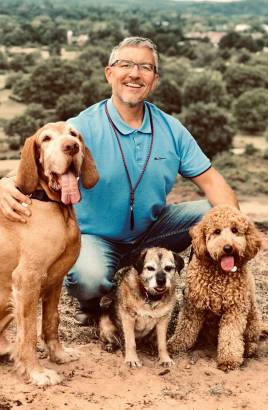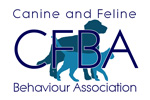The following is a transcript from the 'Your Dog Matters' The Pilot Edition Podcast that I create as seen on the above Anchorfm player. The Youtube video version can be seen here.
Hello and welcome, Nick Jones here, Alpha Dog Behaviour, your friendly dog behaviourist and dog expert witness. What’s the best way to start a podcast? Well, firstly, you learn how to pronounce it and secondly, you just start. So I have decided today to set up the camera. It’s filming from the window so I can create a nice little YouTube video from that. Here I am recording the audio straight into GarageBand on the Mac.
So my mission is to try to do this without feeling like I need to stop to become self-conscious to think about editing because I want this to be one smooth program for you. Now, this is podcast #1. The way I hope to use this material is primarily to create a podcast that will be syndicated on Apple and Amazon, those sorts of services. So I will sort that out later. I haven’t even looked at that yet. I’m sure that’s not difficult. Then also to use the video and that will go on YouTube and most likely on to my Facebook page as well.
So this first program is a pilot. It’s a trial. It’s an opportunity for me just to say, “Look, let’s stop overthinking it. Let’s stop worrying about maintaining fantastic edits that you see on YouTube and just get the information out there.”
I have always enjoyed creating content and I think this is reflected in the social media platforms that I currently use. Social media for me has been a very long term process. I’m approaching my 20th year in practice as a dog behaviourist. Dog expert witness, I guess that has been – it was about four or five years before I started assessing dogs formally, so that’s probably more like 15 years.
I have to thank my brother, Andrew. He has always been the one that said, “Hey Nick, you need to be doing this. You need to be doing that.” And at first, I was somewhat skeptical and not massively interested. I remember when he presented me with my Twitter account and he named – he set it all up without me asking. He set me up as UK Dog Trainer and I think he created a profile and put a few tweaks up for me as well. And he presented it to me as a done deal and at first, I thought, “What is he doing? He set me up a new Twitter account. This was a good while ago. This is when Twitter first came out and then actually, once I got over that, I started to look into it and to realise actually, this was good fun. Twitter when it first came out was awesome.
I am still on Twitter but admittedly, my account is set up so that Facebook echoes on to Twitter, so Twitter is not getting any original content. But we have to be realistic about how many social platforms we can actually really address at once and I’m trying to video and record audio on this at the same time so that we are ending up with say, a smarter approach, rather than me having to do two programmes.
So yes, I enjoy creating content as well as my day job which is going out to meet with cheeky dogs and their owners. And that thankfully has – well, it’s still very much a passion for me. And to do this work, I think in fact it needs to be a passion because if you saw it purely as a 9-5 job, not that it is of course, but if you treat it in that way, I think it would – it’s not a case of you getting bored because this job doesn’t allow you to get bored, but it would I think possibly without that passion the emotional overload of the work would stop you from continuing because there is – and I don’t have any problem with it. I absolutely love my job. But being able to take on new cases on a regular basis with enthusiasm and some drive to help inspire the customer and to move that dog forward does require passion.
And as I say, I’m pleased to still have that passion and long may that continue. I’ve just turned 50 so I see no reason in the next 20 years why I would be stopping this role. So yes, I can see myself now hobbling into customer’s homes as I get a bit older and still up for it.
So yup, very passionate about my role as a behaviourist. Now, why do I call myself a behaviourist? Well, it’s simply because it’s a highfalutin title, isn’t it? And that is not because it’s that but simply because it best defines what I do. I look at dog behaviour primarily. I do not call myself a dog trainer because I see dog train although there are elements of that in my work, but dog trainers tend to work more on class-type environments and looking at those foundation behaviours which are absolutely critical before we can often move on to looking at behaviour. So we need a half well-trained dog before we begin to look at elements of behaviour.
So I simply work in the realms of behaviour because it interests me more personally. I helped a course some years ago running on a help-hire basis and on the face of it, you think how hard can it be? But actually, working with so many dogs and so many people at once, I found wasn’t my strength.
And so my strength I believe is working one-to-one with owners and their dogs. OK? And so that’s something I try to do is play to my strengths. Stay in an area that I feel can bring some genuine value.
So as I say, today’s program is a pilot. It’s not really an emphasis on bringing you any structured points although I do have one or two which I hope you will find are timely. And this is me asking you for ideas because whilst I am sure I will pursue the sort of feel and look I want to offer you, the listener, the viewer, with these podcasts, I would very much appreciate your feedback, OK? Because otherwise, I will be talking to myself and maybe not interesting people as much as I could be. And I want to make this of value.
I also require a podcast name. Now, on here, on my Facebook page this morning which is simply, Facebook.com/AlphaDogBehaviour. I put the page up this morning saying, “Good morning all. I’m requesting for some ideas with podcast names.” Now bless you, I’ve got a few decent ones already and I will – one of the very first ones is one I may well stick with but Shelly kindly suggests, “What about you, me, and our dogs?” OK? So it needs to be sort of interesting without being cliché, the dog podcast and those are all the sorts of things that come up quickly, aren’t they? At least to me that make me think that that’s something I could run with. So we need to have something original.
Another one that Shelly offers, 'Interesting Times with our Dogs and Family'. I like that.
Lisa Gooch, 'Barking Matters'. Now, I like that because I like the play on that title, Barking Matters. It does matter. And then we have the matters of barking. So that is rather good.
Vicky, thank you for this, Vicky. Hope you are well. 'Behave Yourself', 'Sit: The Journey of Wolf', the 'Journey of Bow Wow Wagon Wolf', 'Train Your Owner, A Dog’s Guide'.
This one I like, 'Sit, Stay, Love' as in Eat, Pray, Love. You may have seen that film with Julia Roberts.
And then we have 'Alpha Wolf', the 'Daily, Weekly Wolf'. So certainly yeah, we could make it like newsy content. So we’ve got some nice ideas coming in there. I think the nicest one for me is the first one, 'You, Me, and Our Dogs'. That is something that is – leaves it wide open. I really want the idea here for this podcast to be relaxed, to be me feeling that I can get into this not feeling too self-conscious. I have not – whilst I enjoy doing this type of work, I have not had any media training. So I will try to use the best equipment possible.
The video if you are interested, I’m shooting in 1080. I was tempted to go for 4K, but uploads speed is pretty slow. So it will be 1080 on my RX100 Sony Mark 4. These little cameras are brilliant and sit in the palm of your hand. And that is actually stuck up on a short tripod which is suction-mounted on to the window just behind the video. So that seems to give me enough depth here on the video.
Microphone, I’ve had this thing for years. It’s a little Blue microphone. This is a USB microphone plugged directly into the Mac as I say, and that’s recording on to Garageband.
So as you can tell, some of this is about me getting used to say, my own voice talking non-stop without it’s going, OK, OK, I’ve lost my train of thought and feeling that I can just rely on an edit later on. That’s not what I want to do.
Now, in the sense of offering some content for today’s podcast, I was sitting down, having a think about this because I knew I would get to this point and to discuss with you as well. And the date today is the 2nd of September 2019. And this week, a lot of the children will be going back to school. And so, this idea of going back to school will give probably many mums because still, mums are at home with their children in the school holidays but a lot of those mums are dog owners as well.
And so, this week of going back to school with the kids will hopefully for lots of mums see a return to what you might see as your regular normal routine. So we can also then begin to think about coming back to more of a normal routine, your dog walks. And also, my sort of my work as well, a number of cases, we’ve seen delays which are quite understandable because of things like school holidays and having children around and distracting from some other work that might be on their mind at this moment.
So the idea that I want to present is maybe a bit of coming back to basics. Regardless of the behaviour I’m asked to look at in my day-to-day job, I’m always very keen to ensure that we have the basics in place.
Now, what do I mean by basics? Essentially, I’m thinking of good manners. Is the dog calm? We are not looking to create a robot dog but we want the dog to be mannerly enough and calm enough so that the dog can take direction because a dog which is overly excited and not slowing down enough or not even able to slow down enough to take direction especially if there is a behaviour problem that the owner is looking to address then the problematic behaviours become much harder to address.
Some excellent ways that I find that you can help calm your dog down and here are some off-the-cuff ideas for you. Doorways, will your dog sit and wait for you as you open the door, maybe it’s an internal door or that may go on to a main front door so that you take your dog out for a walk and that walk is likely to either just be on a lead and straight on to the pavement, to the park, or potentially many people will be jumping into a car with their dog and then driving to the location of the walk.
So whether we need to have our dog to be sitting and waiting politely, I usually open the door with my own dogs, obviously, they understand what I want of them. I open the door, count to 5 in my head, and then once I’ve counted 5 because that’s all we need. We don’t need an excessively long delay. We can then encourage our dog to come out of the door with us with a simple OK or “come on,” or “this way,” little phrases that suit you.
Now, these things and it is so basic and it is so simple, but I’m still often struck by how many and this sounds a bit judgmental, I don’t mean it in that way because I’m not judgmental in my work. I hope many existing customers would confirm that, but I am surprised by how many dogs are not sitting and waiting at doorways. And you may think, “Well, is this really going to solve my dog’s pulling or is this really going to solve my dog’s aggression towards other dogs in public?”
Well, in part yes, because no solution has any singular standalone method although some can be more effective than others, but no system has a method which is going to address it in one fell swoop. And we often end up with as I described this layering effect. So we may end up with within that layer three, four, five, six, maybe more different components that we’re bringing together to bring about a solution that can work when this is enforced over a period of time or implemented.
OK. So getting your dog to sit and wait at all doors is an essential component. That can then be extended to other sits and waits that we can carry out in the home as well. So for example, sitting and waiting before you put your dog’s food on the floor. That can also be done with water. Not many people would get their dog to sit and wait before they put water down, especially if the dog is clearly keen to drink water.
So we are not making a big deal out of it, but we are just bringing these very big life essential components to a dog such as eating, drinking, being able to go out and play. If we just put in very short, calming, slowing down elements in front of them then it can change not only how the dog looks at you and sees you and perceives you in this relationship, but it can put your dog in a calmer mindset which then leads to your dog being more likely to be able to listen to you and for you then to be able to press on with other elements of behaviour that you wish to address. OK?
So I’m a great fan of having a calm, mannerly dog. So we’ve got doorways, food, water, access to choose or treats, these are all things where we can continue to ask the dog to sit and wait just for 5 seconds.
Affection. Putting a very brief request in front of you giving affection to your dog, I find can be a very good way to bring about these calming measures. What do I mean by that? How does that look?
We don’t want to be having – we are not trying to set up a formal relationship as such with our dogs so it looks and feels like that all the time. But that we are just being mindful of little things that we can do with our dogs so that they are understanding the flow of the relationship or the structure of the relationship.
And often, the – any experience – any people that are experienced in working with dogs whether it’s training or behaviour, well, you will see a lot of the analogies tend to be very consistent. People will come up with the same sorts of phrases. But a pyramid is one which I’ve come across myself and you will see other trainers use this as well.
Now, the idea of the pyramid is that basically at the top of the pyramid, if we were to imagine an image, we have – we would have the humans and then coming down to the lower parts of the pyramid, we would have our canine friends below us.
Now, some people will start getting a bit twitchy here because they will be thinking that these things feel like some sort of domineering hierarchy. It’s not meant in that way at all. It is just simply meant in an effort to portray an image that the owner very often when I’m explaining how we might like this to look because often rather than it being an upright pyramid where we have – which is what we want to avoid really because we can have potentially the dog at the top of the situation and then the humans below. Well, very often we want an inverted pyramid.
So along the broad line along the top, we have the humans and the family and then coming down to the bottom, we have in a relaxed, calm, comfortable position, our canine friends. OK?
And by slowing our dogs down, by getting them to wait for access to privileged locations or being asked to wait before we give them affection, just through that 5 seconds remember, that can make a big difference in naturally portraying to the dog where we as humans believe they are and that if we consistently reinforce that on an individual and collective family basis that that can make a big difference to our dogs.
Once we spend some time working on these basics, we can then begin to move on to slightly more in-depth techniques at the same time, incidentally I usually just say, “Let’s jump in with all of this at once.” And we can work on the given behaviour whether that's separation anxiety, aggression to dogs in public, fears and phobias, you name it. We always need to ensure that the basics are in place.
OK. So that’s something I think that I would encourage you as parents. Now you are seeing obviously this doesn’t apply for everybody because not all of you have children or children of school age or they may have passed it, but I think this is quite relevant and timely and will apply to many of you.
So focus on slowing your dogs down. Let’s get those good manners back in place. And naturally, if you have some on-going behaviours which are a little bit more in-depth and if this isn’t an advert, but if you would like my assistance then please feel free to contact me. Contact details I think are pretty evident across my websites and social media. If you go, there is a contact page on my website which is AlphaDogBehaviour.co.uk/contact. Fill in the details there and I will gladly receive your email and respond. Usually, I will respond within a few hours every day.
OK. So there you have it. Some thoughts for going back to school, we’ve got a good 20 odd minutes here. One thing I’m not sure about is how long the video camera will record full with – at one length. So don’t – I think it maybe 29 minutes given that it’s showing 22. I think it may cut off at 29 minutes. So that might be a limitation for the future. But we will cross that bridge when we come to it.
Other things that I would like to do in looking into the future are interviews, so interviewing other people in the profession and not just people of my specific role but others in different elements of the dog field as well. So that’s something I will welcome to do.
So I think in the spirit of keeping things short and sweet and getting this first one off the ground, we will call it a day here. I thank you for watching. Please remember to drop me your ideas on subjects that we could cover and especially any ideas on the title for this podcast.
So, thank you for listening. Thank you for watching. And I shall see you all soon








